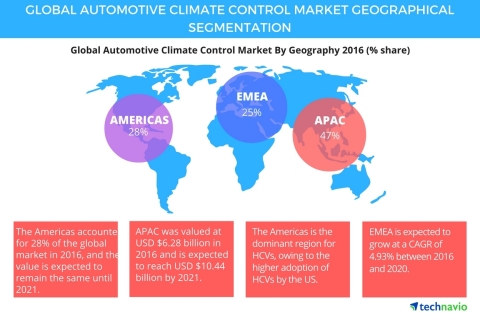LONDON--(BUSINESS WIRE)--The global automotive climate control market is expected to grow at a CAGR of about 9% during the forecast period, according to Technavio’s latest report.
In this report, Technavio covers the market outlook and growth prospects of the global automotive climate control market for 2017-2021. By technology, this market is segmented into automatic and manual climate control systems.
Automatic control systems are widely being adopted into automotive with the increasing use of sensors in vehicles. They need minimum human intervention and work on preset criteria to maintain the climate within the vehicle. Luxury cars are the highest contributors for automatic climate control systems in 2016. This segment is expected to show significant growth with customers from developing and emerging markets opting for luxury vehicles with automatic climate settings.
Increase in long-distance travels and increased commute time for shorter distances is an important driver of the market. The driver and passengers of vehicles expect a good amount of comfort provided by climate control systems during the time spent within the vehicle. To satisfy this need, almost all new models of passenger cars are equipped with climate control units, particularly in regions like the US and China. This feature reduces stress and keeps the driver and passengers comfortable.
Technavio’s research study segments the global automotive climate control market into the following regions:
- APAC
- Americas
- EMEA
APAC: largest automotive climate control market segment
APAC leads the market with a 47% market share in 2016, and is set to show the highest growth rate in the forecast period. China, India, and Japan are the leading countries in the market. The high population density in the region translates to a high-volume adoption on newer vehicles, which are equipped with climate control systems. With a higher percentage of the demographic in the middle-class, there is a shift in preference from mileage to looks and additional features in vehicles; which directly translates to an increased revenue for the automotive climate control market.
“Apart from mass segment-passenger cars, luxury cars are the crucial segment for the market. The customer base for luxury cars give less emphasis on the price point of their automotive, allowing for inclusion of high-end climate control systems, which leads to significant revenue growth. We expect the dominant region for luxury cars to shift from North America to countries like India and China in APAC, which will benefit the climate control market in APAC,” says Siddharth Jaiswal, one of the lead analysts at Technavio for automotive electronics research.
Request a sample report: http://www.technavio.com/request-a-sample?report=54839
Technavio’s sample reports are free of charge and contain multiple sections of the report including the market size and forecast, drivers, challenges, trends, and more.
Americas: market driven by demand for luxury cars
The automotive climate control market in the Americas was valued at USD 3.77 billion in 2016. The major market driver is converted mobile homes which many people spend most of their time in. Spending longer durations within the vehicles necessitates the adoption of technologies that give comfort, one of which is the climate control system. Even though North America occupies the largest market share, Latin American countries like Brazil are significantly contributing to the climate control market. This is mainly due to government initiatives pushing for rapid development of the automotive component industry.
The USA, which occupies the largest market share in the industry, gets most of its revenue from the increasing demand for luxury cars. The baby boomers are older and have high incomes, which they prefer to spend in luxury cars with inclusion of maximum features. BMW is luxury car brand in the US, followed by Mercedes-Benz. The Tesla S, which was recently introduced is creating new intensity in the competition among vendors, which is pushing the market growth.
EMEA: home to the world’s leading automotive manufacturers
“Light commercial vehicles in Europe are expected to witness significant growth during the forecast period, owing to growth in the home delivery sector. Vans are the most preferred vehicles for distributing goods and for city transportation. Original equipment manufacturers in Europe are focusing on the advanced safety features for these vehicles, which will be a major driver for market growth in the region,” says Siddharth.
In terms of revenue, the automotive climate control market in EMEA was valued at USD 3.42 billion in 2016. The major contributors to the automotive climate control in Europe were France, Italy, Germany, and the. Some of the world’s leading automotive manufacturers like BMW and Mercedes-Benz are from Europe, making the market extremely competitive. This has led to high adoption of climate control systems in the region.
The top vendors in the global automotive climate control market highlighted in the report are:
- DENSO
- Hanon Systems
- MAHLE
- Valeo
Browse Related Reports:
- Automotive Industry in Serbia 2016-2020
- Global Automotive HVAC Market 2016-2020
- Global Automotive Telematics Market 2016-2020
Do you need a report on a market in a specific geographical cluster or country but can’t find what you’re looking for? Don’t worry, Technavio also takes client requests. Please contact enquiry@technavio.com with your requirements and our analysts will be happy to create a customized report just for you.
About Technavio
Technavio is a leading global technology research and advisory company. The company develops over 2000 pieces of research every year, covering more than 500 technologies across 80 countries. Technavio has about 300 analysts globally who specialize in customized consulting and business research assignments across the latest leading edge technologies.
Technavio analysts employ primary as well as secondary research techniques to ascertain the size and vendor landscape in a range of markets. Analysts obtain information using a combination of bottom-up and top-down approaches, besides using in-house market modeling tools and proprietary databases. They corroborate this data with the data obtained from various market participants and stakeholders across the value chain, including vendors, service providers, distributors, re-sellers, and end-users.
If you are interested in more information, please contact our media team at media@technavio.com.




